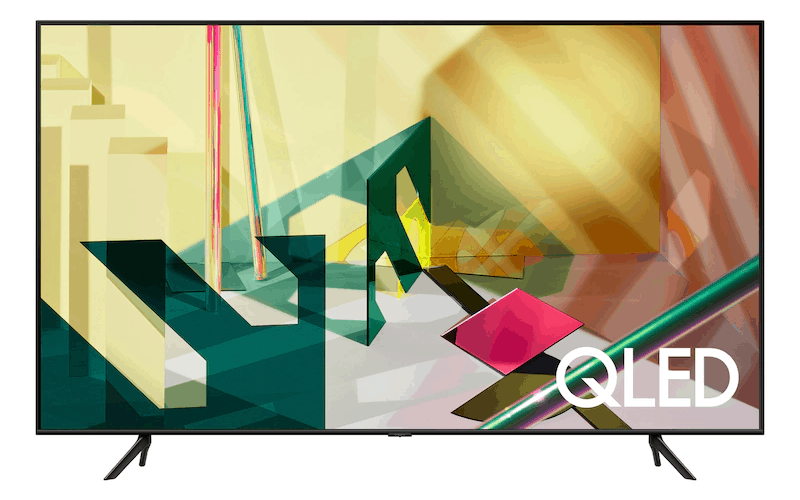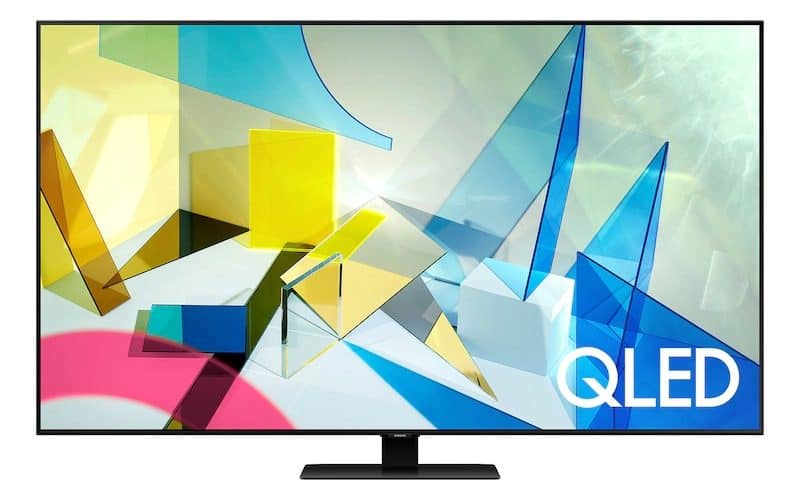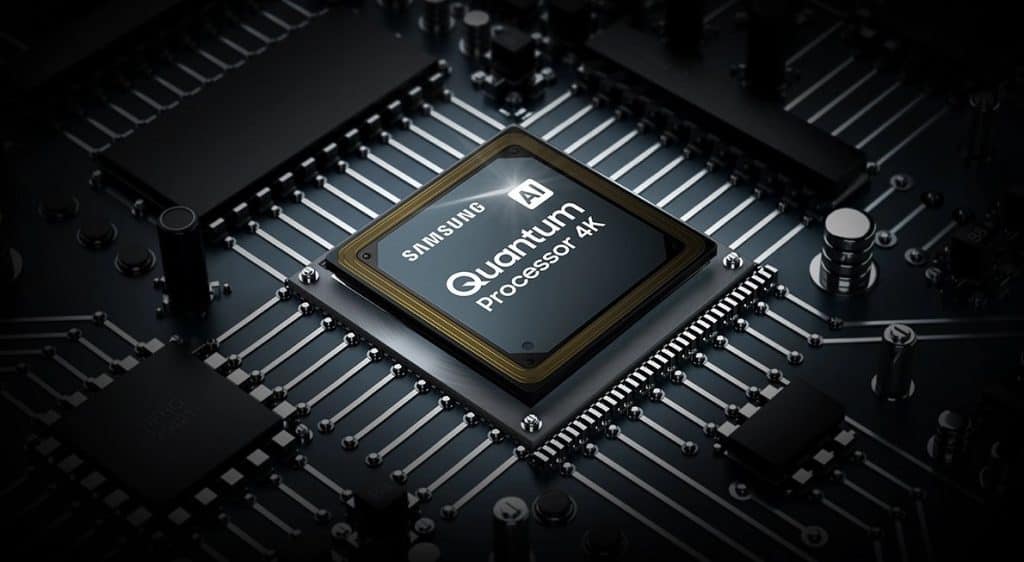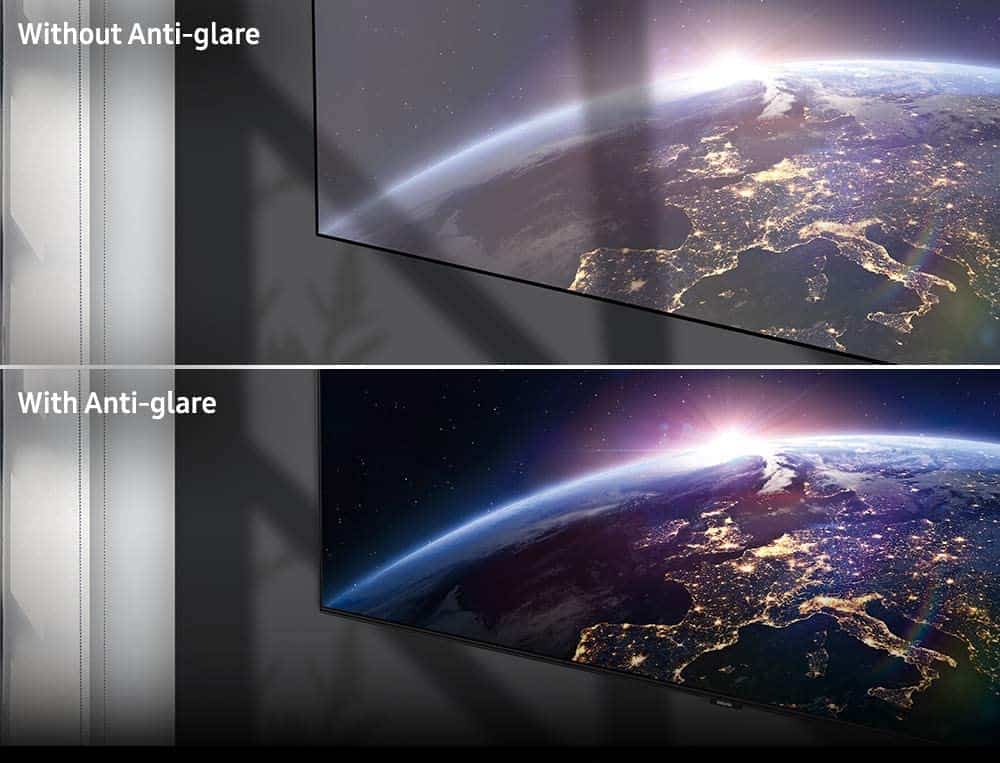When you get a Samsung TV, you know you’re getting a quality product from a reputable brand. Even so, with so many models this manufacturer churns out each year, narrowing down your potential purchase can be challenging.
To help you in this endeavor, we’ve singled out two promising models worth your attention. Read this comprehensive Samsung Q70T vs Q80T comparison page to determine which model is the better choice for you.
Samsung Q70T vs Q80T – Quick Comparison
Samsung Q70T

Samsung Q70T is the epitome of the company’s mid-range TV lineup. It delivers rich and vibrant colors, excellent connectivity and Smart TV properties. All of this at a reasonably solid price, though at the expense of some features. Here’s a brief overview of Q70’s most significant advantages and disadvantages:
Pros:
- Fast, streamlined, and easy-to-use OS
- Great contrast ratio
- Low input lag
- Excels at producing dark colors
Cons:
- Edge-lit TV
- No Dolby Vision
Samsung Q80T

The Samsung Q80T Smart TV is an impressive all-around model. It’s capable of providing a marvelous viewing experience, albeit at a rather hefty price tag. Let’s take a closer look at Q80’s most notable pros and cons:
Pros:
- Fast, streamlined, and easy-to-use OS
- Outstanding anti-glare performance
- Superb local dimming features
- Exceptional motion technology
Cons:
- Often struggles with producing deep dark colors
- Expensive
SEE ALSO: Our Q70R vs Q80R Comparison
Features Face to Face
Panel Technology
As the abbreviations give it away, both the Q70T and Q80T use Samsung’s QLED panel technology. This technology is developed almost exclusively for the best Samsung TVs and licensed only to a handful of other TV manufacturers that cooperate with this South Korean tech giant.
Going into more detail, QLED stands for Quantum Dot Light-Emitting Diode. In simple terms, QLED technology is similar to LED, but it has a quantum dot layer. The main advantage of this layer is that it enhances the colors and brightness the TV produces, resulting in the stunning image quality Samsung TVs are known and praised for.
Image Processor
The two TVs employ the same image processor as all of Samsung’s 4K models. This is the powerful Quantum Processor 4K. It’s a robust but smooth image processor that automatically optimizes the picture to produce a more immersive viewing experience.

The Quantum Processor 4K uses advanced features like Adaptive Picture and 4K AI upscaling to adjust the TV to the lighting conditions in your room, reduce image noise, and define edges around objects and text.
Motion Technology
Samsung models generally offer excellent response times. In the context of this Q70T vs Q80T comparison, the latter model is the better performer. The Q80T offers a remarkable 2.8 millisecond 80% response time, almost five milliseconds better than the Q70T. It can fully transition between scenes in just 10.1 milliseconds, while the Q70T does so in just over 15 milliseconds.
When watching fast-moving content on the Q70T, you might notice some image blur behind objects and some blur in darker scenes. This isn’t as noticeable on the Q80T, as it can keep its pace with fast-moving images, like that in action movies or sports.
Picture Quality
Most casual consumers associate the term “picture quality” with supported resolutions. That said, if you’re going by resolution alone, it’s hard to differentiate the two models, as the Q70T and the Q80T offer indistinguishable picture quality properties in terms of supported resolutions. This comparison table illustrates just how well the two TVs matchup in this category:
| Resolution | Samsung Q70T | Samsung Q80T |
|---|---|---|
| 4K/120Hz | Yes (Native Support) | Yes (Native Support) |
| 4K/60Hz/4:4:4 | Yes | Yes |
| 4K/60Hz | Yes | Yes |
| 1440p/120Hz | Yes (Native Support) | Yes (Native Support) |
| 1440p/60Hz | Yes (Native Support) | Yes (Native Support) |
| 1080p/120Hz | Yes (Native Support) | Yes (Native Support) |
| 1080p/60Hz/4:4:4 | Yes | Yes |
Contrast Ratio / Black Level
While both models offer an excellent contrast ratio, the Q70T noticeably outperforms the Q80T in this category. To put it in specific numbers, the Q80T has a contrast ratio of 3,042:1, while the Q70T has a native contrast of 7,144:1. Such an impressive contrast ratio enables the Q70T to produce deep blacks.
The Q80T has a slightly lower native contrast ratio than what you would expect from a VA panel. This is primarily due to the “Ultra Viewing Angle” layer. Although this characteristic helps the Q80T deliver wider viewing angles, it does so at the expense of the contrast ratio. That said, smaller-sized Q80T models don’t come with this layer. So, for example, you can expect a slightly higher native contrast ratio in a 49’’ model than in a 65’’ or 75’’ model.

Local Dimming
In terms of local dimming features, the Q80T has a clear edge over the Q70T. This is because the Q70T doesn’t even have a local dimming feature. Instead, it is an edge-lit LED TV that uses bulbs placed around the screen’s perimeter.
In contrast, the Q80T has a solid full-array local dimming feature. This allows it to reduce intense blooming around bright objects like subtitles. It is a bit slow in reacting to color changes but still does a decent job in the local dimming department overall.
Peak Brightness
The Q70T and the Q80T provide you with powerful enough peak brightness characteristics to watch content in a very bright room. Looking at their SDR peak brightness, the Q80T outperforms the Q70T in terms of maximum brightness on small screen areas. On the other hand, the Q70T is more consistent and offers nearly identical peak brightness values on small areas of the screen as it does on the entire surface.
Comparing HDR brightness values, the Q80T offers slightly better performance. In comparison, the Q70T offers just passable numbers. The Q70T can perform pretty well in a dark room but delivers a sub-par HDR viewing experience in a brighter setting. Check out the table below for a direct Q70T vs Q80T SDR and HDR brightness comparison:
| Brightness Values | Samsung Q70T | Samsung Q80T |
|---|---|---|
| Peak 10% Window SDR Brightness | ∼ 500 nits | ∼ 710 nits |
| Peak 100% Window SDR Brightness | ∼ 500 nits | ∼ 424 nits |
| Peak 10% Window HDR Brightness | ∼ 490 nits | ∼ 790 nits |
| Peak 100% Window HDR Brightness | ∼ 490 nits | ∼ 440 nits |
Color
The Q70T and the Q80oth enable wide color gamuts, offering equally superb performance in this category. Both models have outstanding coverage of the commonly used DCI P3 color space and equally respectable Rec. 2020 color space coverage.
Regarding the two TV’s color volumes, the Q80T is slightly better but not enough to make a substantial difference in performance. Due to its excellent contrast ratio, the Q70T excels at producing dark colors but doesn’t display very bright blues well. Conversely, the Q80T can’t match the Q70T in terms of dark color reproduction, as it has a significantly lower contrast ratio.
Viewing Angle
As you could expect from VA panels, both the Q70T and the Q80T deliver unimpressive viewing angles and aren’t very suitable for wider seating arrangements. This is especially the case with the Q70T model, which has inferior viewing angles in the context of modern TVs. You don’t have to move much to the side before the images start looking washed out and lose their brightness.
The Q80T does keep brightness loss and black level rise to a minimum even at slightly wider angles, but Gamma shifts start appearing at viewing angles of around twenty percent. Keeping all this in mind, the Q80T offers better viewing angles than the Q70T, but only by a narrow margin.
Reflections / Anti-glare
The Q80T has significantly better anti-glare properties than the Q70T. This is because the Q70T has a semi-gloss finish, while the Q80T has a glossy finish. The difference in the type of coating makes the Q80T much more capable of reducing the intensity of reflected light. As a result, the Q80T reflects only around one percent of the light that hits its surface, five times less than the Q70T.
Sound Quality
Samsung is known for creating innovative and smart features to enhance the sound quality of its TVs. That said, neither the Q70T nor the Q80T can produce top-quality sound. Both models provide a reasonably balanced sound with decent frequency response and can get pretty loud. However, neither TV can deliver the deep and thunderous bass that profoundly impacts the movie-watching experience.
Smart Platform (Operating System)
Like all Samsung TVs, these two models run on the company’s proprietary Tizen Smart TV platform. Furthermore, the Q70T and the Q80T both use the 2020 version of this OS. The 2020 Tizen OS is one of the smoothest smart TV operating systems and is extremely straightforward to use.

This smart platform includes plenty of advanced options and customizable settings. Additionally, it also features a great selection of apps, including HDR native Netflix and Youtube apps.
Connectivity
As modern TV sets are more like home entertainment centers than just plain TVs, they require extended connectivity features to provide you with a variety of linking options. In this sense, the Q70T and the Q80T follow the latest trends and standards and come with all of the required connectivity properties. To get a better understanding of everything this entails, we’ll take a closer look at the following categories:
Inputs
Although the two models differ in some critical performance traits, they offer identical input support. Equally as important, they provide exceptionally low input lag times, especially if you turn on the Game Motion Plus or VRR feature. With that in mind, here’s a brief rundown of the key input features of the Q70T and the Q80T:
| Input Ports | Samsung Q70T | Samsung Q80T |
|---|---|---|
| HDMI Ports | 4 HDMI 2.0 Ports | 4 HDMI 2.0 Ports |
| USB Ports | 2 USB 2.0 Ports | 2 USB 2.0 Ports |
| Digital Optical Audio Out | 1 Port | 1 Port |
| Ethernet Port | Yes | Yes |
Voice Assistants
Apart from sharing the same OS version, the two models also utilize the same remote control and, with that, identical voice assistant properties. The tiny Samsung smart remote that comes with all QLED TV is packed with excellent voice control features, allowing you to control your TV through the remote’s built-in speaker.
Samsung’s Bixby virtual assistant provides you with a broad set of control features. These include opening your TV apps, changing channels, and adjusting the volume or the viewing mode. You can also use it for tasks like controlling the media content or switching between input ports.
Wireless Technologies
Same as most modern Smart TVs, the Q70T and the Q80T use the same Wi-Fi technology (2.4GHz and 5GHz). Moreover, they both offer the same Bluetooth (ver.4.2) support, allowing you to connect any local device you want to pair up with your TV.
Standout Features
Considering all of the above, it’s safe to say that the key standout feature is Q80T’s local dimming feature support. As an edge-lit TV, the Q70T can’t match up to what the Q80 can produce. In the same breath, the Q70T tends to noticeably flicker at times, depending on the frequency you’re running your TV on. Again, this is due to the less-capable edge-lit background.
Conclusion
Both TVs have many similar features, including their identical smart platforms and connectivity properties. In this Samsung Q70T vs Q80T comparison, we’ve also found a long list of differences that enable us to make a recommendation that would fit your budget and preferences.
The Q70T is a solid TV for mixed-usage that performs equally well for gaming, movies, TV shows, and sports. It even outperforms the Q80T when it comes to the native contrast ratio. Not to mention that it is also significantly cheaper than the Q80T.
Even so, if you have a larger budget to work with and want the better features that come with the higher price, you should lean more to the latter model in this Q70T vs Q80T comparison. The Q80T offers better peak brightness performance, local dimming features, wider viewing angles, and stronger anti-glare properties.